Related Research Articles

Westwood is a commercial and residential neighborhood in the northern central portion of the Westside region of Los Angeles, California. It is the home of the University of California, Los Angeles (UCLA). Bordering the campus on the south is Westwood Village, a major regional district for shopping, dining, movie theaters, and other entertainment.
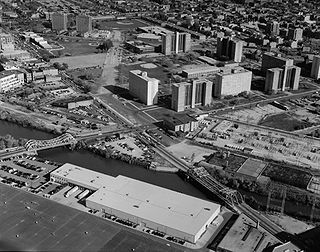
Cabrini–Green Homes was a Chicago Housing Authority (CHA) public housing project on the Near North Side of Chicago, Illinois. The Frances Cabrini Rowhouses and Extensions were south of Division Street, bordered by Larrabee Street to the west, Orleans Street to the east and Chicago Avenue to the south, with the William Green Homes to the northwest.
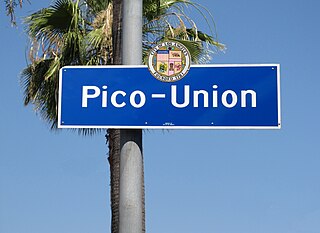
Pico-Union is a neighborhood in Central Los Angeles, California. The name "Pico-Union" refers to the neighborhood that surrounds the intersection of Pico Boulevard and Union Avenue. Located immediately west of Downtown Los Angeles, it is home to over 40,000 residents.
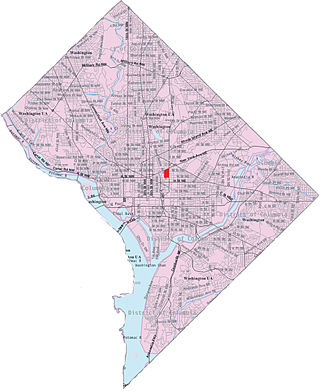
Sursum Corda is a small neighborhood located in Washington, D.C., bounded by North Capitol Street on the east, K Street NW to the south, New Jersey Avenue NW to the west, and New York Avenue NW to the north.
Jordan Downs is a 700-unit public housing apartment complex in Watts, Los Angeles, California, next to David Starr Jordan High School. It consists of 103 buildings with townhouse style units ranging from one bedroom to five bedrooms. The complex is owned and managed by the Housing Authority of the City of Los Angeles (HACLA).

The Harbor Gateway is a 5.14-square-mile residential and industrial area (13.3 km2) in the Los Angeles Harbor Region, in the southern part of the city. The neighborhood is narrow and long, running along a north-south axis. Its unusual shape has given it the alternative name of "the Shoestring Strip". The northern limit of the neighborhood is Imperial Highway, a city street just north of I-105.
HOPE VI is a program of the United States Department of Housing and Urban Development. It is intended to revitalize the worst public housing projects in the United States into mixed-income developments. Its philosophy is largely based on New Urbanism and the concept of defensible space.
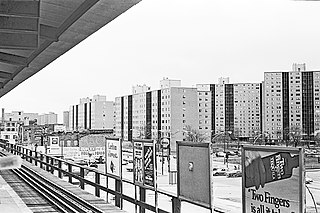
Stateway Gardens was a Chicago Housing Authority (CHA) public housing project located in the Bronzeville neighborhood on the South Side of Chicago, Illinois.

The Housing Authority of New Orleans is a housing authority in New Orleans, Louisiana, tasked with providing housing to low-income residents.
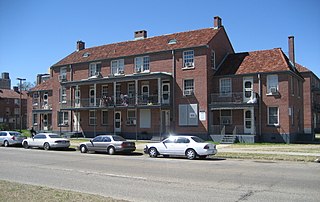
Iberville Projects was a neighborhood in the city of New Orleans and one of the low-income Housing Projects of New Orleans. The Iberville was the last of the New Deal-era public housing remaining in the city. Its boundaries were St. Louis Street, Basin Street, Iberville Street, and North Claiborne Avenue. It is located in the 6th ward of downtown New Orleans, on the former site of the Storyville district. The area has recently been redeveloped into a modernized apartment complex called the Bienville Basin Apartments.
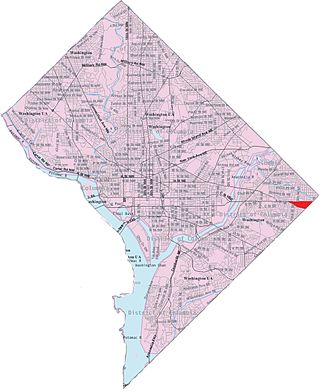
Capitol View is a neighborhood located in southeast Washington, D.C., in the United States. It is bounded by East Capitol Street to the north, Central Avenue SE to the southwest and south, and Southern Avenue SE to the southeast. Still overwhelmingly African-American, it is a thriving middle class neighborhood. Parts of the neighborhood became one of the city's most violent and drug-ridden areas in the 1980s and 1990s. The Capitol View neighborhood saw several large, poorly maintained public housing projects demolished in the 2010s. The government of the District of Columbia partnered with private real estate developers to construct the Capitol Gateway mixed-use development between 2000 and 2010.
The Avalon Gardens is a public housing project located in the Green Meadows neighborhood of Los Angeles, California. It is one of the oldest housing projects owned by the Housing Authority of the City of Los Angeles.

Approximately 1.4 million people in the United States were part of gangs as of 2011, and more than 33,000 gangs were active in the country. These include national street gangs, local street gangs, prison gangs, outlaw motorcycle clubs, and ethnic and organized crime gangs.
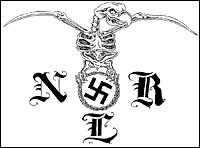
The Nazi Lowriders, also known as NLR or the Ride, are a neo-Nazi, white supremacist organized crime syndicate, and prison and street gang in the United States. Based primarily in Southern California, the gang is allied with the larger Aryan Brotherhood and Mexican Mafia gangs, and fellow peckerwood gang Public Enemy No. 1. The Nazi Lowriders operate both in and outside of prison.
Aliso Village was a housing project in Los Angeles, California. It was built in 1942 and demolished 1999. The 29-acre (120,000 m2) parcel was replaced by Pueblo del Sol.

South Los Angeles, also known as South Central Los Angeles or simply South Central, is a region in southwestern Los Angeles County, lying mostly within the city limits of Los Angeles, south of downtown. It is "defined on Los Angeles city maps as a 16-square-mile rectangle with two prongs at the south end.” In 2003, the Los Angeles City Council renamed this area "South Los Angeles".
Oceanview is a neighborhood in the southern portion of San Francisco, California. It was first established as a community in the 1910s and originally centered on the intersection of Sagamore Street and San Jose Avenue. Today, the neighborhood is bordered by Orizaba Avenue to the west, Lakeview Avenue to the north, and Interstate 280 to the south and east.
The Clarksdale Housing Complex was a housing project located in Louisville, Kentucky directly east of downtown in the Phoenix Hill neighborhood.

Bay Terraces is a hilly urban neighborhood in the southeastern part of San Diego, California, United States. A composite of North Bay Terrace and South Bay Terrace, it is bordered by Skyline to the north, Paradise Hills to the southwest, Alta Vista, South Encanto and National City to the west. The southern end of the neighborhood is bordered by State Route 54 and Bonita. The neighborhood generally includes the ZIP Codes 92114 and 92139 and as such, parts of the area have often been incorrectly referred to as either "Paradise Hills" or "Skyline Hills" due to its proximity and overlapping ZIP Codes. Nevertheless, Bay Terraces is the largest neighborhood in the Skyline-Paradise Hills Community Planning Area.
Orchard Park, also known as "Home of New Edition," was one of Boston's most notorious housing projects, located in Roxbury, Massachusetts. It is also the former home of singer Bobby Brown and New Edition members Ricky Bell, Michael Bivins and Ralph Tresvant. The 350-unit three-story brick complex was built in 1941 and was demolished in 1998 due to crime problems.
References
- ↑ Tamaki, Julie (February 7, 1999). "New Development Revitalizes Area of Harbor City". Los Angeles Times.
- ↑ Murphy, Dean (June 28, 1987). "Crime, Decay in L.A.-Run Housing Spur Study by City". Los Angeles Times.
- ↑ "Affordable Housing in the Nineties: An Evolving Private Sector Role | The Planning Report". www.planningreport.com.
- ↑ "Normont". February 2, 1997.